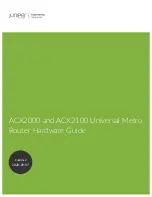
53
•
Enable WAN
: Select
Yes
to allow the router Internet access.
Select
No
to disable Internet access.
•
Enable NAT
: NAT (Network Address Translation) is a system
where one public IP (WAN IP) is used to provide Internet
access to network clients with a private IP address in a LAN.
The private IP address of each network client is saved in a NAT
table and is used to route incoming data packets.
•
Enable UPnP
: UPnP (Universal Plug and Play) allows several
devices (such as routers, televisions, stereo systems, game
consoles, and cellular phone), to be controlled via an IP-based
network with or without a central control through a gateway.
UPnP connects PCs of all form factors, providing a seamless
network for remote configuration and data transfer. Using
UPnP, a new network device is discovered automatically.
Once connected to the network, devices can be remotely
configured to support P2P applications, interactive gaming,
video conferencing, and web or proxy servers. Unlike Port
forwarding, which involves manually configuring port
settings, UPnP automatically configures the router to accept
incoming connections and direct requests to a specific PC on
the local network.
•
Connect to DNS Server
: Allows this router to get the DNS
IP address from the ISP automatically. A DNS is a host on
the Internet that translates Internet names to numeric IP
addresses.
•
Authentication
: This item may be specified by some ISPs.
Check with your ISP and fill them in if required.
•
Host Name
: This field allows you to provide a host name for
your router. It is usually a special requirement from your ISP.
If your ISP assigned a host name to your computer, enter the
host name here.
















































